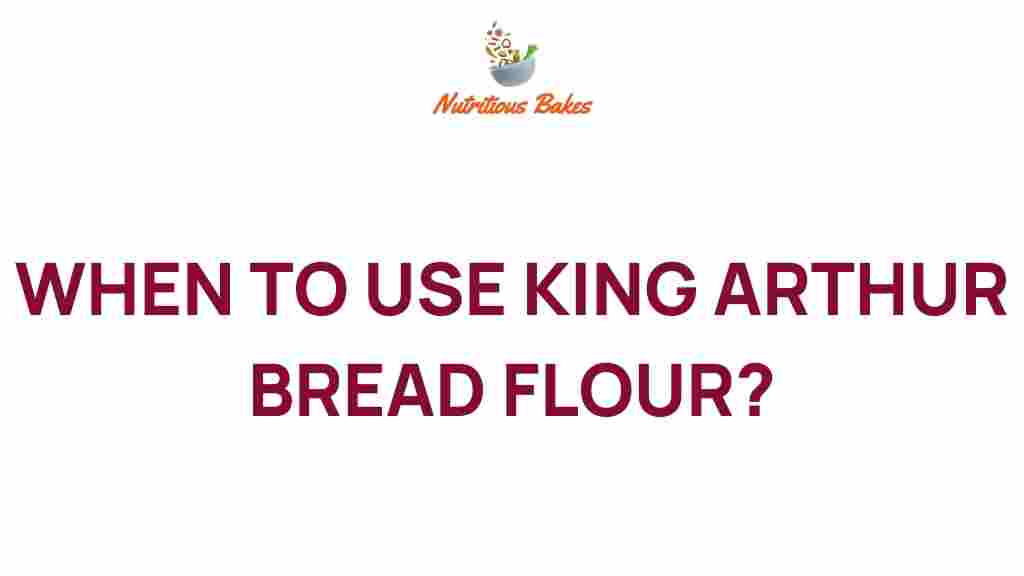Unlocking the Secrets: When to Use King Arthur Bread Flour
When it comes to baking, the type of flour you use can make a significant difference in the outcome of your baked goods. Among the many flour options available, King Arthur bread flour stands out for its high protein content and versatility. Whether you’re a novice baker or a seasoned pro, understanding when and how to use this exceptional flour can elevate your bread-making game to new heights.
Understanding Flour Types
Before diving into the specifics of King Arthur bread flour, it’s essential to understand the various types of flour available and their uses:
- All-Purpose Flour: This is the most versatile flour, suitable for a wide range of baked goods, but it may not provide the structure needed for artisan bread.
- Bread Flour: With a higher protein content (usually around 12-14%), bread flour is ideal for yeast breads, resulting in a chewy texture and good rise.
- Whole Wheat Flour: This flour contains the entire wheat kernel, providing more nutrients and fiber but requiring adjustments in hydration due to its absorbency.
- Pastry Flour: Lower in protein, this flour is perfect for tender pastries and cakes.
Now, let’s explore why King Arthur bread flour is a favorite among bakers.
The Benefits of King Arthur Bread Flour
King Arthur bread flour is renowned for its consistent quality and excellent performance. Here are some reasons why it’s a top choice:
- High Protein Content: Typically around 12.7%, this flour provides the gluten structure necessary for bread, resulting in a chewy and airy crumb.
- Consistency: King Arthur flour is milled from high-quality wheat, ensuring consistent results with every bake.
- Versatility: Suitable not only for bread but also for pizza dough, bagels, and even some pastries.
Baking Tips for Using King Arthur Bread Flour
To make the most of King Arthur bread flour, consider these baking tips:
- Measure Accurately: Use a kitchen scale for precision. A cup of flour can weigh anywhere from 120 to 150 grams depending on how it’s scooped.
- Hydration: Because of its high protein content, you may need to increase the hydration level of your dough to achieve the desired texture.
- Kneading: Knead the dough adequately to develop gluten, ensuring a good rise and structure.
- Resting Time: Allow your dough to rest for better flavor and texture. Longer fermentation times can enhance the bread’s taste.
Step-by-Step Process: Making Artisan Bread with King Arthur Bread Flour
Now that we understand the benefits and tips, let’s walk through a simple artisan bread recipe using King Arthur bread flour.
Ingredients:
- 3 cups King Arthur bread flour
- 1 1/2 teaspoons salt
- 1 teaspoon instant yeast
- 1 1/4 cups water (room temperature)
Instructions:
- Mix Ingredients: In a large mixing bowl, combine the flour, salt, and instant yeast. Gradually add the water and stir until a shaggy dough forms.
- First Rise: Cover the bowl with plastic wrap or a clean kitchen towel and let it rise at room temperature for 12 to 18 hours.
- Shape the Dough: After the first rise, turn the dough out onto a floured surface. Gently shape it into a ball, being careful not to deflate it too much.
- Second Rise: Place the shaped dough into a floured proofing basket or bowl, cover, and let it rise for another 1-2 hours.
- Preheat the Oven: About 30 minutes before baking, preheat your oven to 450°F (232°C) with a Dutch oven inside to heat up.
- Bake: Carefully remove the hot Dutch oven, place the dough inside (you can score the top for a decorative touch), cover, and bake for 30 minutes. Then, remove the lid and bake for an additional 15-20 minutes until golden brown.
- Cool: Let the bread cool on a wire rack before slicing. This step is crucial for the best dough texture.
Troubleshooting Common Issues
Even with the best ingredients and techniques, issues can arise. Here are some common problems when using King Arthur bread flour and how to fix them:
- Dough is Too Sticky: If your dough is too sticky, try adding a little more flour, a tablespoon at a time, until it reaches the desired consistency.
- Bread is Dense: This can happen if the dough wasn’t kneaded enough or if it didn’t rise sufficiently. Ensure proper kneading and give the dough enough time to rise.
- Crumble Texture: If your bread crumbles instead of slicing cleanly, it might be due to underbaking or not allowing it to cool fully before slicing.
Experimenting with Flavors and Techniques
One of the culinary secrets to great bread is to experiment with different flavors and techniques. Here are some ideas to enhance your baking with King Arthur bread flour:
- Herbs and Spices: Incorporate dried herbs like rosemary or spices like garlic powder into your dough for added flavor.
- Mix in Whole Grains: Try adding a portion of whole wheat flour for a nuttier flavor and denser texture.
- Use a Starter: For a more complex flavor, consider using a sourdough starter instead of commercial yeast.
For more advanced baking techniques, consider checking out King Arthur Baking School for classes and tutorials.
Conclusion
In conclusion, King Arthur bread flour is a versatile and high-quality ingredient that can transform your baking experience. By understanding the different flour types, employing baking tips, and following a reliable recipe, you can create delightful artisan bread with the perfect dough texture. Remember, baking is both a science and an art; don’t hesitate to experiment and find what works best for you. Happy baking!
For more delicious bread recipes and baking techniques, visit our recipe collection.
This article is in the category Tips and created by NutritiousBakes Team
